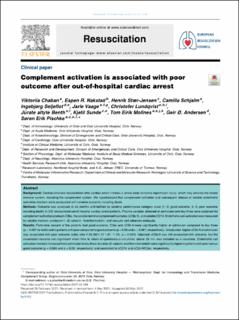| dc.description.abstract | Background
Cardiopulmonary resuscitation after cardiac arrest initiates a whole-body ischemia-reperfusion injury, which may activate the innate immune system, including the complement system. We hypothesized that complement activation and subsequent release of soluble endothelial activation markers were associated with cerebral outcome including death.
Methods
Outcome was assessed at six months and defined by cerebral performance category scale (1−2; good outcome, 3−5; poor outcome including death) in 232 resuscitated out-of-hospital cardiac arrest patients. Plasma samples obtained at admission and day three were analysed for complement activation products C3bc, the soluble terminal complement complex (sC5b-9), and soluble CD14. Endothelial cell activation was measured by soluble markers syndecan-1, sE-selectin, thrombomodulin, and vascular cell adhesion molecule.
Results
Forty-nine percent of the patients had good outcome. C3bc and sC5b-9 were significantly higher at admission compared to day three (p < 0.001 for both) and in patients with poor compared to good outcome (p = 0.03 and p < 0.001, respectively). Unadjusted, higher sC5b-9 at admission was associated with poor outcome (odds ratio 1.08 (95% CI 1.01–1.14), p = 0.024). Adjusted, sC5b-9 was still associated with outcome, but the association became non-significant when time to return-of-spontaneous-circulation above 25 min was included as a covariate. Endothelial cell activation markers increased from admission to day three, but only sE-selectin and thrombomodulin were significantly higher in patients with poor versus good outcome (p = 0.004 and p = 0.03, respectively) and correlated to sCD14 and sC5b-9/C3bc, respectively.
Conclusion
Complement system activation, reflected by sC5b-9 at admission, leading to subsequent endothelial cell activation, was associated with poor outcome in out-of-hospital cardiac arrest patients. | en_US |

